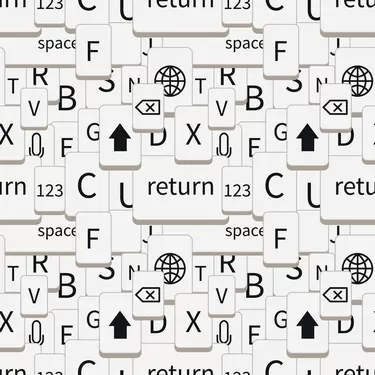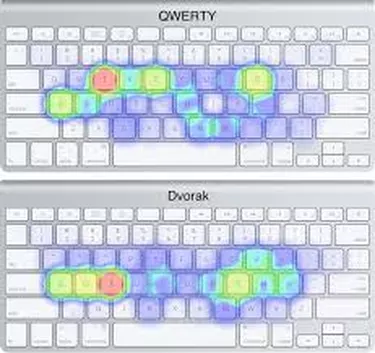If you're thinking about switching the keyboard you use, here's everything you need to make the right decision (for you and your fingers).
What is QWERTY?

If you're reading this in the U.S., then chances are that you are using a QWERTY keyboard. QWERTY gets its name from the first five keys in the top left of the keyboard. It is first mystifying, but if you take a second to glance down, it's a pretty obvious and straight forward name.
Video of the Day
Video of the Day
The QWERTY keyboard is leftover from the era of type writers. Those prone to nostalgia for the clacks of a keyboard (we're right there with you) might think, "That sounds great! Why would I ever switch keyboards?"
Typewriters were designed to meet different needs than computers. The QWERTY keyboard was specifically designed to keep the most used keys away from each other so that the typewriter wouldn't jam if you were typing fast. When we switched to computers, we eliminated the risk of jamming, but kept the distance between the most frequently used keys. Our fingers are now getting a lot of unnecessary exercise, and with how frequently most Americans type these days, all that extra stretching and straining for different keys can result in injures — hello, carpal tunnel!
Dvorak vs. Colemak
The two most widely used alternative keyboards to QWERTY are Dvorak and Colemak.
Dvorak
In 1936, Dr. August Dvorak patented the "Dvorak Simplified Keyboard." Dvorak rearranged the keyboard, placing the most commonly used keys in the home row, and the least commonly used keys in the bottom row, where they are hardest to reach. Whereas the QWERTY keyboard results in the user performing most of the keystrokes with their left hand, Dvorak results in the user favoring their right hand, which is great news if you're right hand dominant.
Dvorak was designed to create a more streamlined, efficient layout. It is also the most different from the QWERTY layout, so it can be the more difficult keyboard to learn.
Colemak
The Colemak keyboard is more similar to the QWERTY than the Dvorak, so it can be easier to learn if you've been using QWERTY for years. Only 17 changes have been made from the QWERTY layout. Like the Dvorak, the Colemak keyboard puts the most frequently used keys in the home row.
Switching
Many users of the Dvorak and Colemak keyboards boast faster typing speeds and less discomfort while typing. We should note that there are no definitive studies demonstrating these claims, but if you find that you're feeling the strain of using a QWERTY keyboard, you may benefit from switching — hey, it's worth a shot, right?
We will say that switching keyboards can be a pain (no pun intended). When you first switch, you will be typing much more slowly. Remember the mindful way you had to scan for each key when you first learned to use the QWERTY keyboard? You'll be doing that again, except this time you'll be fighting against muscle memory of the QWERTY keys.
That said, there are definitely ways to set yourself up for success with different tools.
How to switch the keyboard settings on your computer
All computers allow you to change the default keyboard setting. If you have a Mac, directions can be found here. For PC people, helpful instructions are here.
Keyboard covers
You're not going to find a laptop in the U.S. that comes with a Dvorak or a Colemak keyboard. The easiest, and cheapest, solution for most computers is to pick up a keyboard cover. There's no need to place new stickers on each key and it allows you to easily switch back to QWERTY if you need a break.
KB Covers makes great keyboard covers for Mac, and they offer both Dvorak and Colemak options. You choose your computer model, too, so that the cover is sure to fit your keyboard perfectly.
For PC users, the options are a little different. You can pick up a Dvorak keyboard on Amazon, but it's pretty expensive ($339). Keyboard covers aren't offered, so if you don't want to shell out that much dough, your best bet is going to pick up some keyboard stickers. We recommend the stickers that also allow you to see the QWERTY keys, so you have the flexibility to switch back and forth. You can find stickers for both Dvorak and Colemak on Amazon. It's a more labor-intensive solution, but it's also the cheapest option. Most stickers are under $3.
Changing the keyboard on your phone
If you're making the switch, we recommend you take a holistic approach. Using a Colemak keyboard on your computer and using QWERTY on your phone is a recipe for ongoing headaches and a mess of typos.
Directions for how to change the settings on your Android phone can be found here.
For iPhone users, it's a little more complicated. Apple only allows for keyboard changes to hardware; for iPad, iPhone, and iPod that means the only official way to change your keyboard is to attach an external keyboard. This isn't really a solution for anyone planning to use Dvorak and/or Colemak on the daily. Lucky for us, some enterprising folks have come up with an alternative. There are apps that allow you to download the Dvorak and Colemak keyboards in the app store, though at this time there are only three options available. The good news is that they're all pretty inexpensive— two of them are $0.99, and one is $1.99. The bad news is that auto-correct is not currently supported on the keyboards, so you'll have to fix your own typos again.
Learning your new keyboard
If this new habit has any chance of sticking, you're going to have to practice. Get ready to head back to typing class! The Typing Cat offers a variety of typing classes to increase your speed or learn Dvorak, and the basic level is free. Colemak.com can point you in the direction of a variety of platforms to help you master the Colemak keys.
The verdict?
Learning a new keyboard takes work. It's not as easy as flipping a switch. On top of switching your computer settings, you're also going to have to purchase a keyboard cover/keyboard, and change the settings on your phone. Then, you're going to have to learn the new keys. You should expect to spend at least four weeks learning the new keyboard, and after that you'll find yourself mystified when you're on a QWERTY keyboard.
If you don't have a problem typing on QWERTY, it's probably better to stay there.
If you're experiencing discomfort, or if you type a lot for work, it may be worth it to make the switch. The work now may save you from a bigger problem down the line.
